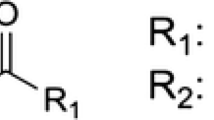Abstract
Skin sensitization is an important toxic endpoint in the risk assessment of chemicals. In this paper, structure–activity relationships analysis was performed on the skin sensitization potential of 357 compounds with local lymph node assay data. Structural fragments were extracted by GASTON (GrAph/Sequence/Tree extractiON) from the training set. Eight fragments with accuracy significantly higher than 0.73 (p < 0.1) were retained to make up an indicator descriptor fragment. The fragment descriptor and eight other physicochemical descriptors closely related to the endpoint were calculated to construct the recursive partitioning tree (RP tree) for classification. The balanced accuracy of the training set, test set I, and test set II in the leave-one-out model were 0.846, 0.800, and 0.809, respectively. The results highlight that fragment-based RP tree is a preferable method for identifying skin sensitizers. Moreover, the selected fragments provide useful structural information for exploring sensitization mechanisms, and RP tree creates a graphic tree to identify the most important properties associated with skin sensitization. They can provide some guidance for designing of drugs with lower sensitization level.

Similar content being viewed by others
References
Golla S, Madihally S, Robinson RL Jr, Gasem KA (2009) Quantitative structure–property relationship modeling of skin sensitization: a quantitative prediction. Toxicol In Vitro 23:454–465
Warne MA, Nicholson JK, Lindon JC, Guiney PD, Gartland KP (2009) A QSAR investigation of dermal and respiratory chemical sensitizers based on computational chemistry properties. SAR QSAR Environ Res 20:429–451
EU, Directive 2003/15/EC of the European Parliament and the Council of 27 February 2003 Amending Council Directive 76/768/EEC on the Approximations of Laws of the Member States Relating to Cosmetic Products. Official Journal of the European Union, L: Legislation 66:26-35. http://www.eur-lex.europa.eu/LexUriServ/LexUriServ.do?uri=OJ:L:2003:066:0026:0035:en:PDF
Commission of the European Communities, White Paper on the Strategy for a Future Chemicals Policy. COM 88 (2001) Brussels, Belgium. http://www.europa.eu.int/comm/environment/chemicals/whitepaper.htm
Commission of the European Communities, Proposal for a Regulation of the European Parliament and of the Council Concerning the Registration, Evaluation, Authorisation and Restriction of Chemicals(REACH), Establishing a European Chemicals Agency and Amending Directive 1999/45/EC and Regulation (EC) on Persistent Organic Pollutants (2003). http://www.europa.eu.int/comm/enterprise/chemicals/chempol/whitepaper/reach.htm
Commission of the European Communities, Regulation (EC) No 1907/2006 of the European Parliament and of the Council of 18 December 2006 concerning the Registration, Evaluation, Authorisation and Restriction of Chemicals (REACH), establishing a European Chemicals Agency, Amending Directive 1999/45/EC and Repealing Council Regulation (EEC) No 793/93 and Commission Regulation (EC) No 1488/94 as well as Council Directive 76/769/EEC and Commission Directives 91/155/EEC, 93/67/EEC, 93/105/EC and 2000/21/EC. Official Journal of the European Union, L: Legislation 396,49:1-849 (pp 14, 374, 37s5). http://www.europa.eu.int/comm/enterprise/reach/index_en.htm
Patlewicz G, Aptula AO, Roberts DW, Uriarte E (2008) A minireview of available skin sensitization (Q)SARs/Expert systems. QSAR Comb Sci 27:60–76
Netzeva T, Pavan M, Worth AP (2008) Review of (quantitative) structure–activity relationships for acute aquatic toxicity. QSAR Comb Sci 27:77–90
The CAESAR model for skin sensitization. http://www.caesar-project.eu/workshop/info.htm, December 5, 2010
Yuan H, Huang J, Cao C (2009) Prediction of skin sensitization with a particle swarm optimized support vector machine. Int J Mol Sci 10:3237–3254
Rusinko A 3rd, Farmen MW, Lambert CG, Brown PL, Young SS (1999) Analysis of a large structure/biological activity data set using recursive partitioning. J Chem Inf Comput Sci 39(6):1017–1026
Roberts DW, Patlewicz G, Kern PS, Gerberick F, Kimber I, Dearman RJ, Ryan CA, Basketter DA, Aptula AO (2007) Mechanistic applicability domain classification of a local lymph node assay dataset for skin sensitization. Chem Res Toxicol 20:1019–1030
Gerberick GF, Vassallo JD, Foertsch LM, Price BB, Chaney JG, Lepoittevin JP (2007) Quantification of chemical peptide reactivity for screening contact allergens: a classification tree model approach. Toxicol Sci 97:417–427
Li S, Fedorowicz A, Andrew ME (2007) A new descriptor selection scheme for SVM in unbalanced class problem: a case study using skin sensitisation dataset. SAR QSAR Environ Res 18:423–441
Miller MD, Yourtee DM, Glaros AG, Chappelow CC, Eick JD, Holder AJ (2005) Quantum mechanical structure–activity relationship analyses for skin sensitization. J Chem Inf Model 45:924–929
Natsch A, Emter R, Ellis G (2009) Filling the concept with data: integrating data from different in vitro and in silico assays on skin sensitizers to explore the battery approach for animal-free skin sensitization testing. Toxicol Sci 107:106–121
Patlewicz G, Dimitrov SD, Low LK, Kern PS, Dimitrova GD, Comber MI, Aptula AO, Phillips RD, Niemela J, Madsen C, Wedebye EB, Roberts DW, Bailey PT, Mekenyan OG (2007) TIMES-SS–a promising tool for the assessment of skin sensitization hazard. A characterization with respect to the OECD validation principles for (Q)SARs and an external evaluation for predictivity. Regul Toxicol Pharmacol 48:225–239
http://www.toxnet.nlm.nih.gov/cgi-bin/sis/htmlgen?HSDB, May 23, 2011
http://www.inchem.org/pages/sids.html, May 24, 2011
Kreiling R, Hollnagel HM, Hareng L, Eigler D, Lee MS, Griem P, Dreessen B, Kleber M, Albrecht A, Garcia C, Wendel A (2008) Comparison of the skin sensitizing potential of unsaturated compounds as assessed by the murine local lymph node assay (LLNA) and the guinea pig maximization test (GPMT). Food Chem Toxicol 46(6):1896–1904
Bergstrom MA, Andersson SI, Broo K, Luthman K, Karlberg AT (2008) Oximes: metabolic activation and structure–allergenic activity relationships. J Med Chem 51(8):2541–2550
Fedorowicz A, Singh H, Demchuk E (2004) QSAR study of skin sensitization using local lymph node assay data. Int J Mol Sci 5:56–66
Sybyl, Tripos Inc.: St. Louis, MO 63144-2913
AMPAC, Semichem, Inc.: Shawnee, KS 66216
Fedorowicz A, Singh H, Soderholm S, Demchuk E (2005) Structure–activity models for contact sensitization. Chem Res Toxicol 18:954–969
Comprehensive Descriptors for Structural and Statistical Analysis (CODESSA), Semichem, Inc.: Shawnee, KS 66216
Accelrys Discovery Studio, Accelrys Software Inc.: San Diego, CA
Chattaraj PK, Sarkar U, Roy DR (2006) Electrophilicity index. Chem Rev 106:2065–2091
Nijssen S, Kok J (2004) A quickstart in frequent structure mining can make a difference. In: 10th ACM SIGKDD international conference on knowledge discovery and data mining (KDD), pp 647–652
Kazius J, Nijssen S, Kok J, Back T, Ijzerman AP (2006) Substructure mining using elaborate chemical representation. J Chem Inf Model 46:597–605
Pipeline Pilot, Accelrys Software Inc.: San Diego, CA
Li S, Fedorowicz A, Singh H, Soderholm SC (2005) Application of the random forest method in studies of local lymph node assay based skin sensitization data. J Chem Inf Model 45:952–964
Zheng M, Luo X, Shen Q, Wang Y, Du Y, Zhu W, Jiang H (2009) Site of metabolism prediction for six biotransformations mediated by cytochromes P450. Bioinformatics 25:1251–1258
Youden WJ (1950) Index for rating diagnostic tests. Cancer 3(1):32–35
Roberts DW, Aptula AO, Patlewicz G, Pease C (2008) Chemical reactivity indices and mechanism-based read-across for non-animal based assessment of skin sensitisation potential. J Appl Toxicol 28:443–454
Langton K, Patlewicz GY, Long A, Marchant CA, Basketter DA (2006) Structure–activity relationships for skin sensitization: recent improvements to Derek for Windows. Contact Derm 55:342–347
Enoch SJ, Roberts DW, Cronin MT (2009) Electrophilic reaction chemistry of low molecular weight respiratory sensitizers. Chem Res Toxicol 22:1447–1453
Roberts DW, Aptula AO, Patlewicz G (2007) Electrophilic chemistry related to skin sensitization. Reaction mechanistic applicability domain classification for a published data set of 106 chemicals tested in the mouse local lymph node assay. Chem Res Toxicol 20:44–60
http://www.sdsc.edu/CCMS/Packages/cambridge/pluto/atom_types.html
Gerberick GF, Ryan CA, Kern PS, Schlatter H, Dearman RJ, Kimber I, Patlewicz GY, Basketter DA (2005) Compilation of historical local lymph node data for evaluation of skin sensitization alternative methods. Dermatitis 16:157–202
Patlewicz GY, Wright ZM, Basketter DA, Pease CK, Lepoittevin JP, Arnau EG (2002) Structure–activity relationships for selected fragrance allergens. Contact Derm 47:219–226
Burton J, Danloy E, Vercauteren DP (2009) Fragment-based prediction of cytochromes P450 2D6 and 1A2 inhibition by recursive partitioning. SAR QSAR Environ Res 20:185–205
Gulyaeva N, Zaslavsky A, Chait A, Zaslavsky B (2001) Measurement of the relative hydrophobicity of organic compounds without organic solvent Effects of salt composition and pH on organic acids and nonionic compounds. J Pharm Sci 90(9):1366–1374
Roberts DW, Aptula AO, Patlewicz G (2006) Mechanistic applicability domains for non-animal based prediction of toxicological endpoints. QSAR analysis of the schiff base applicability domain for skin sensitization. Chem Res Toxicol 19:1228–1233
Roberts DW, Basketter DA (2000) Quantitative structure–activity relationships: sulfonate esters in the local lymph node assay. Contact Derm 42:154–161
Lee JG, Jeong HY, Lee H (2003) An efficient method to compute partial atomic charges of large molecules using reassociation of fragments. Bull Korean Chem Soc 24:369–376
Zefirov NS, Kirpichenok MA, Ismailov FF, Trofimov MI (1987) Calculation schemes for atomic electronegativities in molecular graphs within the framework of Sanderson principle. Dokl Akad Nauk SSSR 296:883–887
Kirpichenok MA, Zefirov NS (1987) Electronegativity and molecular geometry. I. General principles of the method and analysis of the effect of short-range electrostatic interactions on bond lengths in organic molecules. Zh Org Khim 23:673–691
Basketter D, Dooms-Goossens A, Karlberg AT, Lepoittevin JP (1995) The chemistry of contact allergy: why is a molecule allergenic? Contact Derm 32:65–73
Divkovic M, Pease CK, Gerberick GF, Basketter DA (2005) Hapten-protein binding: from theory to practical application in the in vitro prediction of skin sensitization. Contact Derm 53:189–200
Pichler WJ (2001) Predictive drug allergy testing: an alternative viewpoint. Toxicology 158:31–41
Stanton DT, Jurs PC (1990) Development and use of charged partial surface area structural descriptors in computer-assisted quantitative structure–property relationship studies. Anal Chem 62:2323–2329
Acknowledgments
This work was supported by Hi-TECH Research and Development Program of China (Grant 2006AA020402), National S&T Major Project (Grants 2009ZX09301-001, 2009ZX09501-001), and the State Key Program of Basic Research of China (Grant 2009CB918502).
Author information
Authors and Affiliations
Corresponding authors
Electronic supplementary material
Below is the link to the electronic supplementary material.
Rights and permissions
About this article
Cite this article
Lu, J., Zheng, M., Wang, Y. et al. Fragment-based prediction of skin sensitization using recursive partitioning. J Comput Aided Mol Des 25, 885–893 (2011). https://doi.org/10.1007/s10822-011-9472-7
Received:
Accepted:
Published:
Issue Date:
DOI: https://doi.org/10.1007/s10822-011-9472-7




